
A power station, also referred to as a power plant and sometimes generating station or generating plant, is an industrial facility for the generation of electric power. Power stations are generally connected to an electrical grid.

A thermal power station is a type of power station in which heat energy is converted to electrical energy. In a steam-generating cycle heat is used to boil water in a large pressure vessel to produce high-pressure steam, which drives a steam turbine connected to an electrical generator. The low-pressure exhaust from the turbine enters a steam condenser where it is cooled to produce hot condensate which is recycled to the heating process to generate more high pressure steam. This is known as a Rankine cycle.
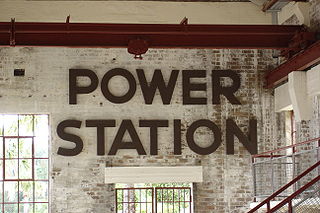
The Balmain Power Station was located at Iron Cove, 4 km (2 mi) from Sydney in New South Wales, Australia. The station no longer exists and residential properties now occupy the site. This plant is often confused with the White Bay Power Station, the remains of which are still standing in Rozelle.
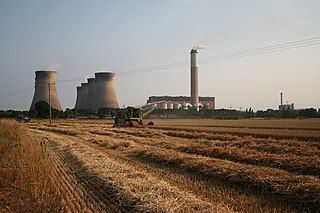
Cottam power station is a decommissioned coal-fired power station. The site extends over 620 acres (250 ha) of mainly arable land and is situated at the eastern edge of Nottinghamshire on the west bank of the River Trent at Cottam near Retford. The larger coal-fired station, was decommissioned by EDF Energy in 2019 in line with the UK's goal to meet its zero-coal power generation by 2025. The smaller in-use station is Cottam Development Centre, a combined cycle gas turbine plant commissioned in 1999, with a generating capacity of 440 MW. This plant is owned by Uniper.
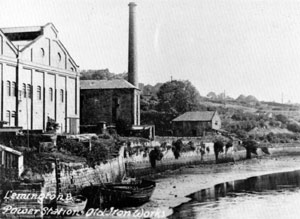
Lemington Power Station was a small, now demolished coal-fired power station, located in North East England. It was situated on the Lemington Gut, a backwater of the River Tyne, at Lemington, 3.5 mi (5.6 km) west of Newcastle upon Tyne. The station's main building stood until 2017 as a rare example of an early power station, dating from before the nationalisation of the United Kingdom's electrical supply industry.

Carville Power Station refers to a pair of now partially demolished coal-fired power stations, situated in North East England on the north bank of the River Tyne at Wallsend. The two stations were built alongside each other on a riverside site about 5 mi (8.0 km) downstream of Newcastle upon Tyne. Carville A Power Station, the first station on the site was opened in 1904, and Carville B Power Station was opened in 1916 to its south.

Forth Banks Power Station was a coal-fired power station in North East England. It was situated in the city centre of Newcastle upon Tyne on Forth Banks, a street to the rear of Newcastle Central station. Put up in a disused factory building in 1890 by the Newcastle and District Electric Lighting Company (DisCo), it is notable as the first power station in the world to use turbo alternators, as well as being one of the first municipal power stations in the United Kingdom.
Neptune Bank Power Station was a coal-fired power station situated on the River Tyne at Wallsend near Newcastle upon Tyne. Commissioned in 1901 by the Newcastle upon Tyne Electric Supply Company, the station was the first in the world to provide electricity for purposes other than domestic and street lighting. It was also the first in the world to generate electricity using three-phase electrical power distribution at a voltage of 5,500 volts.

The West Burton power stations are a pair of power stations on the River Trent near Gainsborough, Lincolnshire, England. West Burton A was a coal-fired power station, which was commissioned in 1966 and operated until 2023, and West Burton B is a combined cycle gas turbine power station, commissioned in 2013. West Burton A is owned by EDF Energy, while West Burton B is owned and operated by EIG Global Energy Partners.

High Marnham Power Station was a coal fuelled power station in Nottinghamshire, to the west of the River Trent, approximately 0.5 miles (0.8 km) north of the village of High Marnham. Construction site clearance began in November 1955, No. 1 Unit power generation commenced in October 1959, and the station became fully operational in June 1962. The plant operated until 2003 when it was decommissioned, though the cooling towers weren't demolished until 2012.
Close Power Station was a coal-fired power station situated on Newcastle upon Tyne's Quayside, in modern Tyne and Wear. The station was built by the Newcastle and District Electric Lighting Company in 1902, near their Forth Banks Power Station.

Willington Power Station is a pair of partly demolished coal-fired power stations that were constructed in the 1950s. The two stations were built on a site off Twyford Road, between Willington and Findern in Derbyshire, England. The two power stations had an installed capacity totaling 804 MW. The two stations consisted of the 'A' Station, and the 'B' Station.
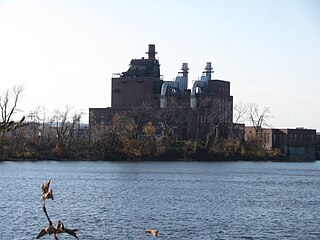
The West Springfield Generating Station, also known by its corporate name EP Energy Massachusetts, LLC, was a fossil-fuel-fired power plant located in West Springfield, Massachusetts. The station was a "peaking" facility, meaning that it primarily operates during peak electrical demand. The facility consisted of two 49-megawatt (MW) combustion turbine generators fueled by natural gas or ultra low-sulphur diesel fuel, one 18 MW jet turbine that was fueled by kerosene, and one 107 MW simple-cycle steam boiler unit burning no. 6 fuel oil, ULSD or natural gas. The station also had a small auxiliary boiler for process and building heat and an emergency back-up generator.

Foss Island Power Station, also known as York Power Station, was a small 40 MW coal-fired power station serving the city of York.
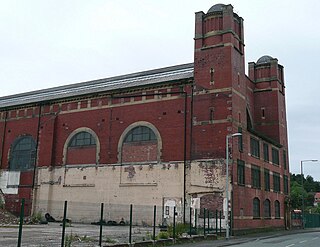
Stalybridge, Hyde, Mossley & Dukinfield Tramways & Electricity Board (SHMD) was a public transport and electricity supply organisation formed by Act of the British Parliament in August 1901. It was a joint venture between the borough councils of Stalybridge, Hyde, Mossley and Dukinfield. The system was officially opened on 21 May 1904.
The Charing Cross and Strand Electricity Supply Corporation Limited was a British electricity undertaking. It was incorporated as a public company in 1889 to generate and supply electricity to parts of the City of Westminster, Holborn and later the City of London. From 1925 it worked jointly with other companies as part of the London Power Company. The company was abolished on 31 March 1948 when the British electricity industry was nationalised, and its assets were transferred to the British Electricity Authority and the London Electricity Board. The Charing Cross Corporation's Bow power station continued in operation until 1969.

Leicester power stations are a series of electricity generating stations that have provided electric power to the City of Leicester and the wider area from 1894. The first station, located within Aylestone gas works, supplied electricity for street lighting. The city's new electric tram system was supplied from 1904 by a station at Lero which operated until 1930. A large coal-fired power station was constructed at Freemans Meadow in 1922 and was operational until 1976. Finally a gas turbine power plant was commissioned in 1976.
Carlisle power stations were two electricity generating stations that supplied electricity to Carlisle and the surrounding area from 1899 until 1980. The first power station (1899–1927) was in the centre of the city near Nelson Bridge, and the second larger station was at Willow Holme North-West of the city (1923–1980).
The Lancaster power stations provided electricity to the Lancashire town and city of Lancaster and the surrounding area from 1894 to 1976. The first power station was built and operated by Lancaster Corporation and started generating electricity in April 1894. The second power station was built during the First World War near the Lune Aqueduct to provide electric power for a munitions factory. When the factory closed after the war the power station was purchased by the corporation to provide electric power throughout its supply area.
Bristol power stations supplied electricity to the City of Bristol and the surrounding area from 1893 to 1959. Temple Back and Avonbank power stations were built by the Bristol Corporation which operated them up to the nationalisation of the British electricity supply industry in 1948.
















